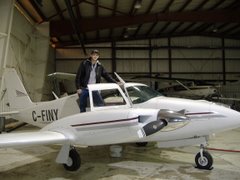It doesn't look like I can get down to our 200' survey height without going into cloud, so I'll stay a little bit higher, and then when we clear the cloud layer I'll drop in on a steep descent down to the proper altitude. We'll have to re-fly the portion of the line where we are too high later, but that's not a huge deal. The rest of the block is CAVOK (Clouds And Visibility OK). I already have the power pulled back in anticipation of our steep dive - its very easy to bury the airspeed indicator's needle past Vne (Never Exceed Speed) of 210 mph (much slower than a normal Navajo's Vne since we have our survey sensors hanging off the end of the wingtips).
We cross over the shoreline cliffs and continue our descent down below until we're skimming the sea at our usual 200'. These cliffs have caused us some consternation lately. The last few flights the wind tumbling over them has caused some severe turbulence for us, so much that we've had to avoid them entirely. In those cases you have to tighten your seatbelt as much as possible, and then you can look out the window and watch the wingtips flex up and down as they bounce through the rough air. Today the air is smooth but its the cloud cover preventing us from surveying over them.
Two hours into the flight, 50 nautical miles off shore. We bear down on a tiny little sailboat, maybe a 26 or 28 footer. Its wavy for him out here, he's bobbing like a cork but clearly sailing to somewhere. We wonder where he came from. He's a least a full day's sail from land in the direction he came from - he must have had a rough time this morning. The ocean swells now are rocking him pretty good, and it was even windier this morning. Kind of looks like fun actually. Our next line a half an hour later takes us right over top of him. Our belly camera must have surely snapped a picture of him as we went over, it might make for a cool photo. I make a mental note. We continue our precision flying back and forth, blue sea, blue sea, blue sea.
Four hours into the flight. We're headed in to land. As always the wind is blowing in from the water, so I've set us up for a tight left downwind for runway 27. Its tight because there's some tall hills to the right of me, so I can either fly a wider, higher circuit at 1500' above airport elevation, or stick to the standard 1000' circuit and stay tighter in and away from the hills. I prefer the tighter, lower circuit, but it makes for a challenging base-final approach. Its tight enough that its almost a continuous 180° descending left turn all the way down onto the runway. I'm proficient enough in the Navajo now that I can make these high demand approaches and still stay ahead of the airplane no problem. One hundred hours ago I wouldn't have the confidence to try something like this in the Navajo, but now that I'm getting consistent left-seat practice I'm really starting to meld with the airplane. It feels good.
I touch down right wheel first in the light crosswind with a bit of a bump, the remaining wheels come down smoothly. Good flight.




No comments:
Post a Comment